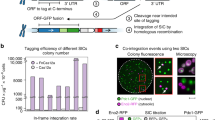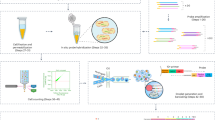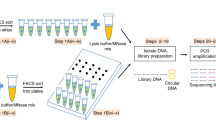Abstract
Microarray-based comparative genomic hybridization has become a widespread method for the analysis of DNA copy number changes across the human genome. Initial methods for microarray construction using large-insert clones required the preparation of DNA from large-scale cultures. This rapidly became an expensive and time-consuming process when expanded to the number of clones needed for higher resolution arrays. To overcome this problem, several PCR-based strategies have been developed to enable array construction from small amounts of cloned DNA. Here, we describe the construction of microarrays composed of human-specific large-insert clones (40–200 kb) using a specific degenerate oligonucleotide PCR strategy. In addition, we also describe array hybridization using manual and automated procedures and methods for array analysis. The technology and protocols described in this article can easily be adapted for other species dependent on the availability of clone libraries. According to our protocols, the procedure will take approximately 3 days from labeling the DNA to scanning the hybridized slides.
This is a preview of subscription content, access via your institution
Access options
Subscribe to this journal
Receive 12 print issues and online access
$259.00 per year
only $21.58 per issue
Buy this article
- Purchase on Springer Link
- Instant access to full article PDF
Prices may be subject to local taxes which are calculated during checkout




Similar content being viewed by others
Change history
28 June 2007
In the version of this article originally published online, the author omitted to acknowledge the contributions of the following parties to this article: The protocols described in Steps 1-9 were originally developed by Sean Humphray and members of the Wellcome Trust Sanger Institute Core Mapping Group; Steps 15–27 were originally developed or are modified from protocols developed by David Vetrie, Cordelia Langford and other members of the Wellcome Trust Sanger Institute Microarray Facility. The original protocols are available at http://www.sanger.ac.uk/Projects/Microarrays/arraylab/protocol3b.pdf and http://www.sanger.ac.uk/Projects/Microarrays/arraylab/protocol4.pdf. The authors are supported by the Wellcome Trust. This error has been corrected in the PDF version of the article.
References
Kallioniemi, A. et al. Comparative genomic hybridization for molecular cytogenetic analysis of solid tumors. Science 258, 818–21 (1992).
Lichter, P., Joos, S., Bentz, M. & Lampel, S. Comparative genomic hybridization: uses and limitations. Semin. Hematol. 37, 348–57 (2000).
Pinkel, D. et al. High resolution analysis of DNA copy number variation using comparative genomic hybridization to microarrays. Nat. Genet. 20, 207–211 (1998).
Solinas-Toldo, S. et al. Matrix-based comparative genomic hybridization: biochips to screen for genomic imbalances. Genes Chromosomes Cancer 20, 399–407 (1997).
Geigl, J.B. et al. Multiplex-fluorescence in situ hybridization for chromosome karyotyping. Nat. Protoc. 1, 1172–1184 (2006).
Douglas, E.J. et al. Array comparative genomic hybridization analysis of colorectal cancer cell lines and primary carcinomas. Cancer Res. 64, 4817–4825 (2004).
Hurst, C.D. et al. High-resolution analysis of genomic copy number alterations in bladder cancer by microarray-based comparative genomic hybridization. Oncogene 23, 2250–63 (2004).
Mulholland, P.J. et al. Genomic profiling identifies discrete deletions associated with translocations in glioblastoma multiforme. Cell Cycle 5, 783–791 (2006).
Koolen, D.A. et al. A novel microdeletion, del(2)(q22.3q23.3) in a mentally retarded patient, detected by array-based comparative genomic hybridization. Clin. Genet. 65, 429–432 (2004).
Koolen, D.A. et al. A new chromosome 17q21.31 microdeletion syndrome associated with a common inversion polymorphism. Nat. Genet. 38, 999–1001 (2006).
Rosenberg, C. et al. Array-CGH detection of micro rearrangements in mentally retarded individuals: clinical significance of imbalances present both in affected children and normal parents. J. Med. Genet. 43, 180–186 (2006).
Sharp, A.J. et al. Discovery of previously unidentified genomic disorders from the duplication architecture of the human genome. Nat. Genet. 38, 1038–1042 (2006).
Shaw-Smith, C. et al. Microdeletion encompassing MAPT at chromosome 17q21.3 is associated with developmental delay and learning disability. Nat. Genet. 38, 1032–1037 (2006).
Shaw-Smith, C. et al. Microarray based comparative genomic hybridisation (array-CGH) detects submicroscopic chromosomal deletions and duplications in patients with learning disability/mental retardation and dysmorphic features. J. Med. Genet. 41, 241–248 (2004).
Vissers, L.E. et al. Array-based comparative genomic hybridization for the genomewide detection of submicroscopic chromosomal abnormalities. Am. J. Hum. Genet. 73, 1261–1270 (2003).
Vissers, L.E. et al. Mutations in a new member of the chromodomain gene family cause CHARGE syndrome. Nat. Genet. 36, 955–957 (2004).
Iafrate, A.J. et al. Detection of large-scale variation in the human genome. Nat. Genet. 36, 949–951 (2004).
Redon, R. et al. Global variation in copy number in the human genome. Nature 444, 444–454 (2006).
Sebat, J. et al. Large-scale copy number polymorphism in the human genome. Science 305, 525–528 (2004).
Locke, D.P. et al. Large-scale variation among human and great ape genomes determined by array comparative genomic hybridization. Genome Res. 13, 347–357 (2003).
Perry, G.H. et al. Hotspots for copy number variation in chimpanzees and humans. Proc. Natl. Acad. Sci. USA 103, 8006–8011 (2006).
Wilson, G.M. et al. Identification by full-coverage array CGH of human DNA copy number increases relative to chimpanzee and gorilla. Genome Res. 16, 173–181 (2006).
Fiegler, H. et al. Accurate and reliable high-throughput detection of copy number variation in the human genome. Genome Res. 16, 1566–1574 (2006).
Ichimura, K. et al. Small regions of overlapping deletions on 6q26 in human astrocytic tumours identified using chromosome 6 tile path array-CGH. Oncogene 25, 1261–1271 (2006).
Ishkanian, A.S. et al. A tiling resolution DNA microarray with complete coverage of the human genome. Nat. Genet. 36, 299–303 (2004).
Redon, R. et al. Tiling path resolution mapping of constitutional 1p36 deletions by array-CGH: contiguous gene deletion or “deletion with positional effect” syndrome? J. Med. Genet. 42, 166–171 (2005).
Snijders, A.M. et al. Assembly of microarrays for genome-wide measurement of DNA copy number. Nat. Genet. 29, 263–264 (2001).
Buckley, P.G. et al. A full-coverage, high-resolution human chromosome 22 genomic microarray for clinical and research applications. Hum. Mol. Genet. 11, 3221–3229 (2002).
Hodgson, G. et al. Genome scanning with array CGH delineates regional alterations in mouse islet carcinomas. Nat. Genet. 29, 459–464 (2001).
Fiegler, H. et al. DNA microarrays for comparative genomic hybridization based on DOP-PCR amplification of BAC and PAC clones. Genes Chromosomes Cancer 36, 361–374 (2003).
Telenius, H. et al. Degenerate oligonucleotide-primed PCR: general amplification of target DNA by a single degenerate primer. Genomics 13, 718–725 (1992).
Foreman, P.K. & Davis, R.W. Real-time PCR-based method for assaying the purity of bacterial artificial chromosome preparations. Biotechniques 29, 410–412 (2000).
Cai, W.W. et al. Genome-wide detection of chromosomal imbalances in tumors using BAC microarrays. Nat. Biotechnol. 20, 393–396 (2002).
Fare, T.L. et al. Effects of atmospheric ozone on microarray data quality. Anal. Chem. 75, 4672–4675 (2003).
Author information
Authors and Affiliations
Corresponding author
Ethics declarations
Competing interests
The authors declare no competing financial interests.
Rights and permissions
About this article
Cite this article
Fiegler, H., Redon, R. & Carter, N. Construction and use of spotted large-insert clone DNA microarrays for the detection of genomic copy number changes. Nat Protoc 2, 577–587 (2007). https://doi.org/10.1038/nprot.2007.53
Published:
Issue Date:
DOI: https://doi.org/10.1038/nprot.2007.53
This article is cited by
-
Regions of XY homology in the pig X chromosome and the boundary of the pseudoautosomal region
BMC Genetics (2013)
-
Array painting: a protocol for the rapid analysis of aberrant chromosomes using DNA microarrays
Nature Protocols (2009)
-
Single-cell isolation from cell suspensions and whole genome amplification from single cells to provide templates for CGH analysis
Nature Protocols (2007)
Comments
By submitting a comment you agree to abide by our Terms and Community Guidelines. If you find something abusive or that does not comply with our terms or guidelines please flag it as inappropriate.



